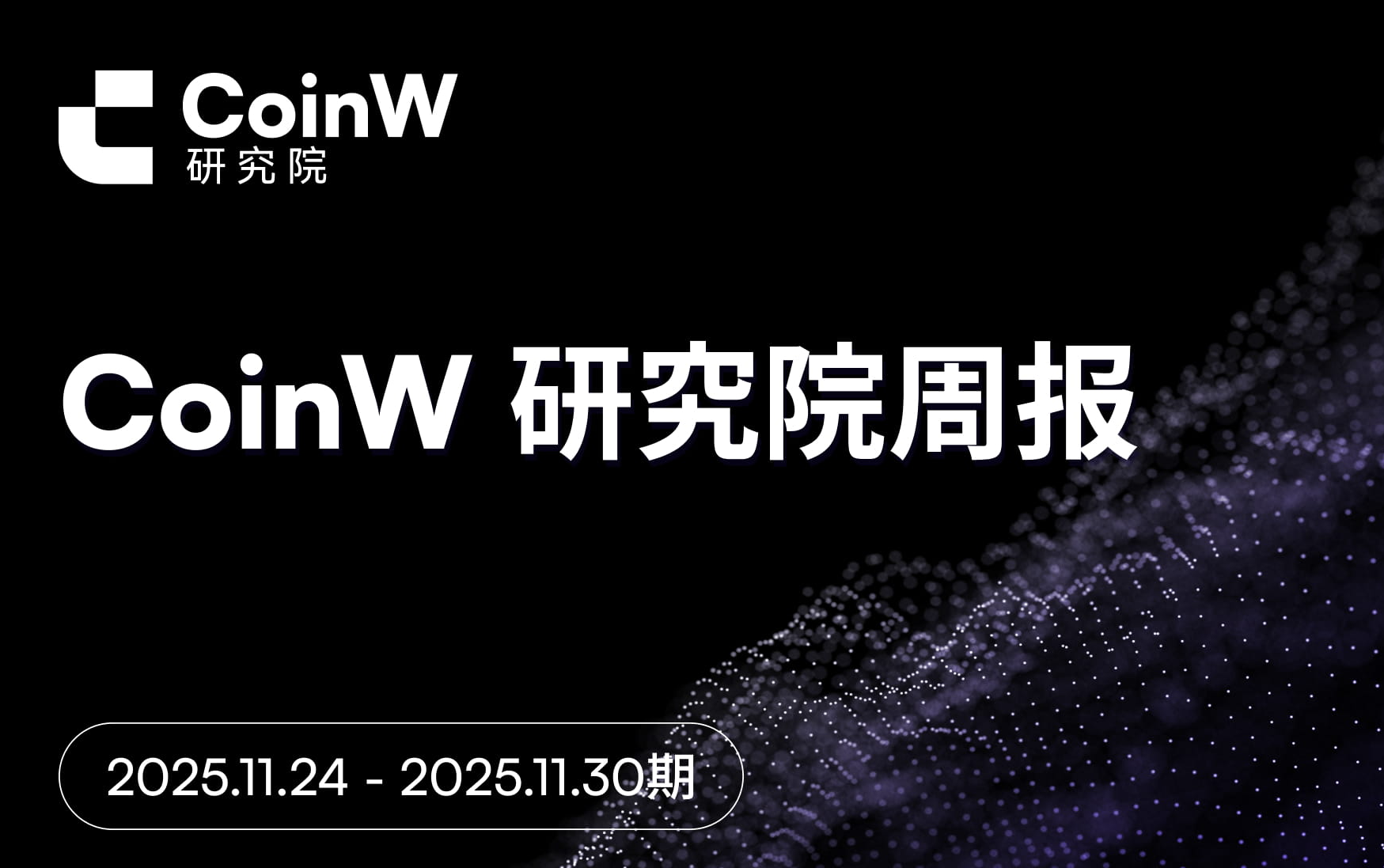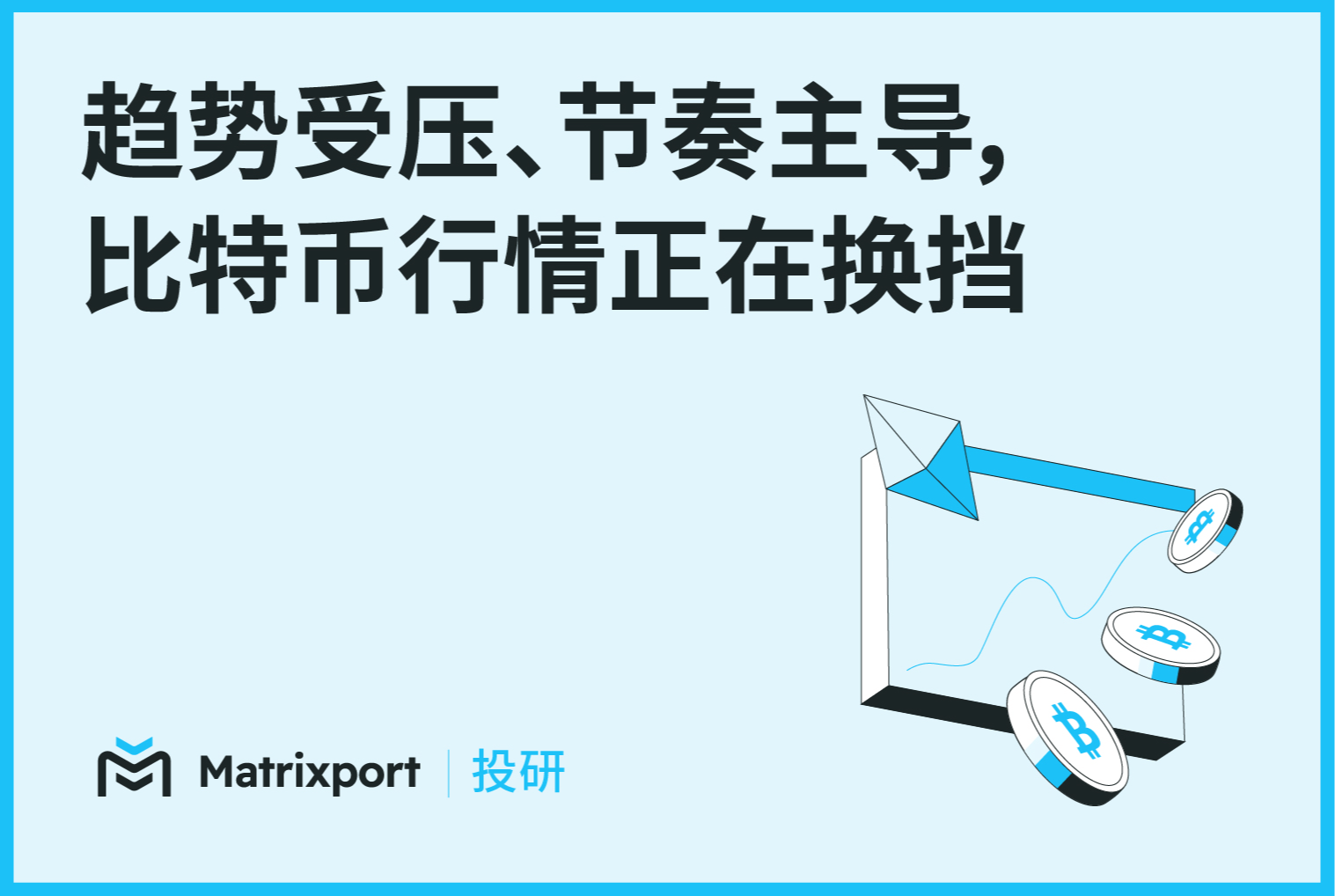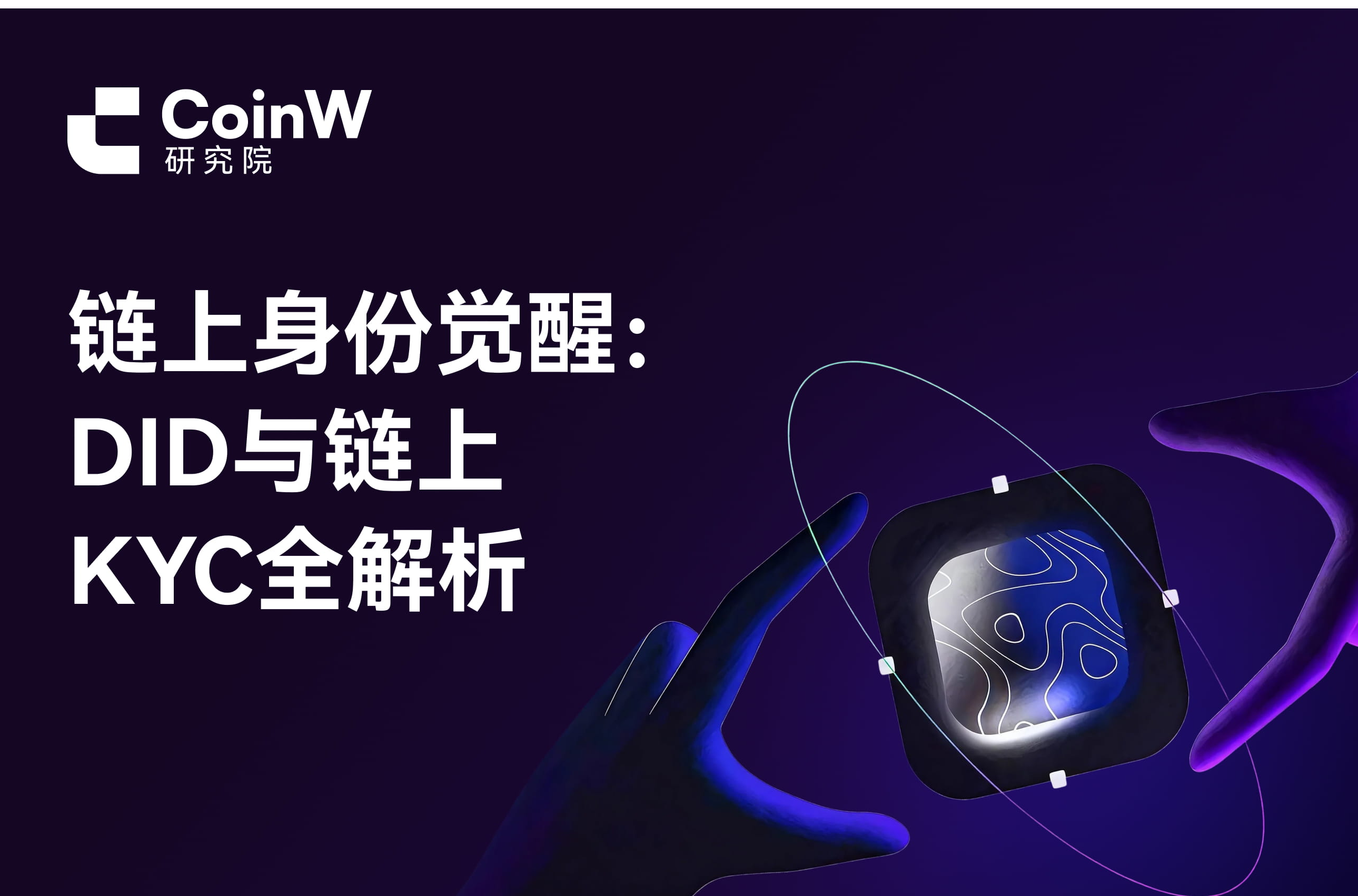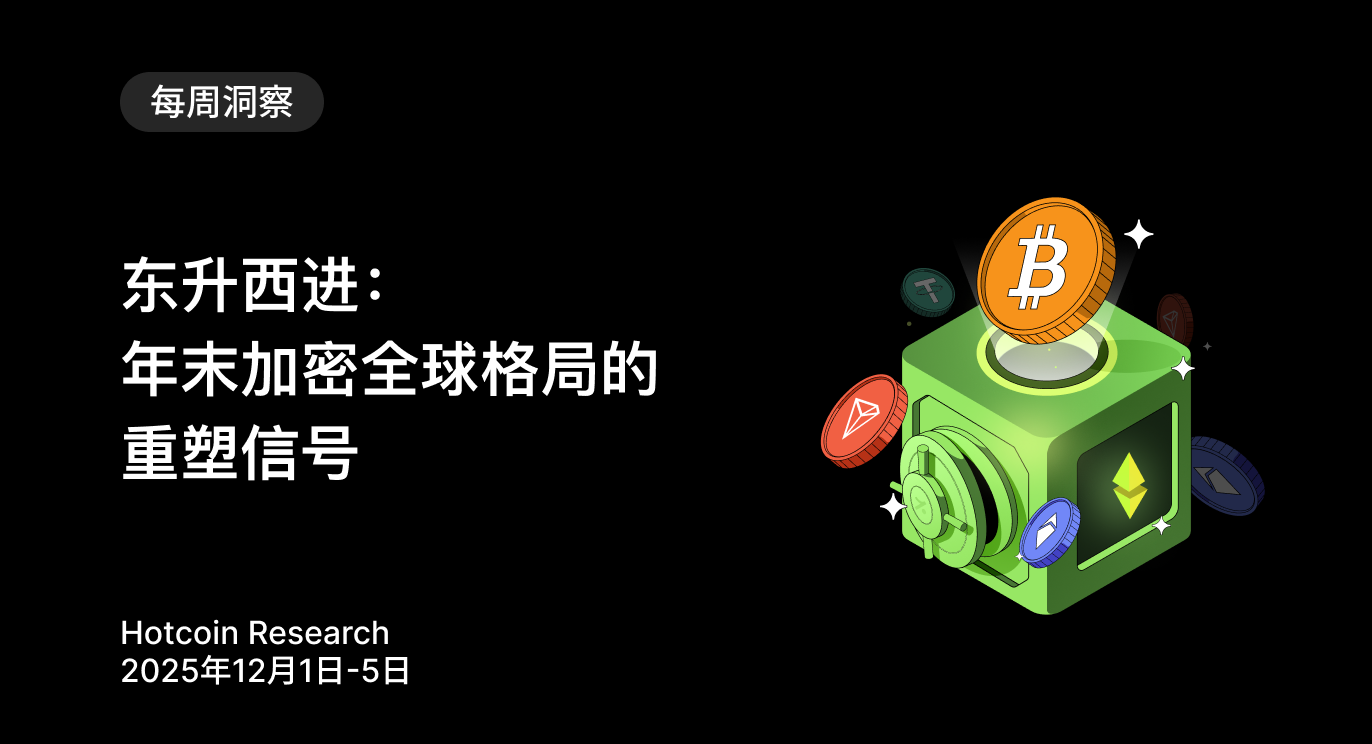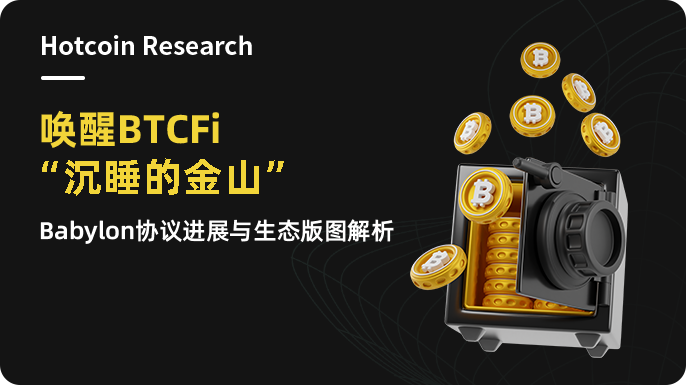
Introduction
With the booming development of DeFi, Bitcoin, as the cornerstone of the cryptocurrency field, has become the focus of industry attention due to the expansion of its ecosystem and the innovation of application scenarios. However, the Bitcoin network, due to its use of Proof of Work (PoW) consensus, inherently does not support native staking, which has left a large amount of BTC assets in a "dormant" state in the DeFi field for a long time. The emergence of the Babylon protocol has created a new model for Bitcoin staking: without changing the Bitcoin mainnet, bridging, or custody, users can utilize their BTC to provide security for other blockchains and earn returns, bringing Bitcoin into the PoS economy, allowing BTC to have both the attributes of a store of value and an income-generating asset, thus promoting the rise of the BTCFi ecosystem.
This article will delve into the technical mechanisms and innovations of the Babylon protocol, summarize its staking data and performance, review representative projects in the Babylon ecosystem, and discuss the challenges and opportunities currently faced by Babylon, as well as future development prospects.
1. Analysis of the Innovative Mechanisms of the Babylon Protocol
1. Non-Custodial BTC Staking Model
The Babylon protocol cleverly enables native BTC to participate in staking while maintaining user self-custody. Unlike traditional cross-chain bridges that lock BTC and issue alternatives like WBTC, Babylon does not introduce third-party custody or token bridging; all operations are completed directly on the Bitcoin mainnet. The core lies in Bitcoin script locking and signature verification: BTC holders generate special staking transactions on-chain, locking BTC in a script address with time-lock and multi-signature conditions. The beacon chain/PoS chain deployed by Babylon can recognize these locked transactions and verify the associated Bitcoin signatures, thus recording how much BTC has been staked by which public key addresses. During the staking period, BTC remains under the control of the user's own Bitcoin address, and can only be unlocked upon meeting preset conditions (such as staking expiration or authorized withdrawal). This design achieves a staking model without trusting third parties and keeps BTC on the mainnet, significantly reducing risk.
2. Overcoming the Challenges of Native BTC Staking
Currently, about 27% of ETH participates in staking, but nearly 0% of BTC can earn staking rewards. Babylon activates this untapped potential through a "time-space separation" design to achieve cross-chain shared security: BTC continues to be held on the Bitcoin network, while the Babylon chain and its service's PoS network reference the existence of these BTC as economic collateral. This does not require an upgrade of the Bitcoin network's smart contract capabilities or a hard fork to adjust rules—Babylon staking transactions are just ordinary Bitcoin transactions, utilizing existing script functions to construct staking locking and withdrawal conditions.
3. Finality Providers and BTC Security Integration
Babylon does not modify the Bitcoin protocol itself but introduces a layer of "control plane" on top of Bitcoin—the Babylon PoS beacon chain. This chain is built using the Cosmos SDK and serves as the "management layer" of the Babylon system, responsible for aggregating the security of BTC staking and providing finality services to other blockchains. When Bitcoin stakers generate staking transactions, they delegate their BTC to a "finality provider." The finality provider can be seen as a validator node on the Babylon chain, operated by professional institutions. They cannot touch the user's BTC but have the authority to represent the user in using this portion of Bitcoin's economic weight to vote for the PoS network, provide checkpoints, and finality proofs.
4. Security and Withdrawal Mechanism
BTC staked in Babylon can be withdrawn at any time, with BTC locked for a maximum of about 64,000 Bitcoin blocks (approximately 15 months) during staking. If users wish to unlock early, they need to initiate an unstaking transaction, which must be verified for validity and jointly signed by a constraint committee, allowing BTC to enter a 7-day on-chain unlocking period before being returned to the user. Throughout this process, the committee can only approve correct unlocks, and cannot arbitrarily transfer the user's BTC or prevent automatic unlocking upon staking expiration. Additionally, there is no slashing mechanism for Bitcoin staking in Phase-1—users do not need to sign any messages agreeing to penalties, and even if their delegated PoS validator fails, the user's BTC will not be affected. This alleviates early users' concerns about security.
5. Multi-Chain Sharing and Scalability
Babylon's long-term vision is to achieve "one BTC, multiple stakes" in Phase-3. At that time, a certain amount of BTC staked by a user can simultaneously be used for security guarantees across multiple PoS networks (referred to by Babylon as "Bitcoin Secured Networks," BSN). The Babylon PoS chain will act as a control hub, coordinating how the same BTC is allocated voting weight across different networks, allowing BTC holders to earn multi-chain rewards simultaneously. This Liquid Restaking concept is similar to Ethereum's EigenLayer, but the underlying staked asset is BTC, and introducing BTC as a shared staking asset is expected to enhance the overall PoS ecosystem's resistance to volatility and security. Moreover, Babylon does not involve cross-chain bridges, significantly reducing the risk of bridge hacks.
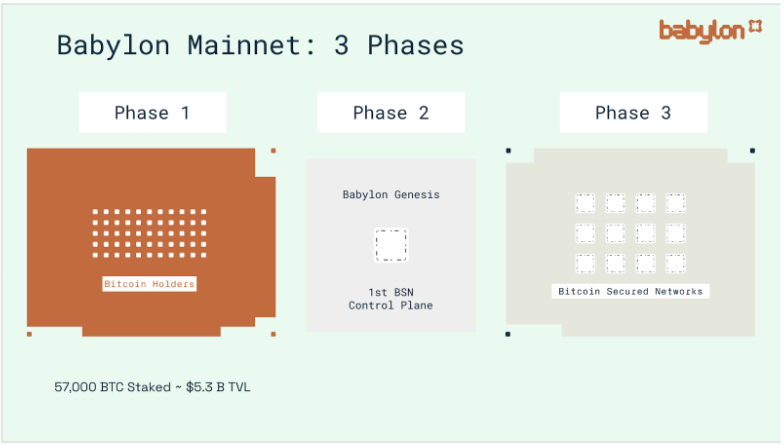
Source: https://babylon.foundation/blogs
2. Progress and Performance of Bitcoin Staking in Babylon
The Bitcoin Staking Protocol Phase-1 launched by Babylon in 2024 adopts a phased opening of staking approach. The official divides Phase-1 into three stages (Cap-1, Cap-2, Cap-3), each with different staking limits and participation rules, to gradually test and expand the scale of BTC staking.
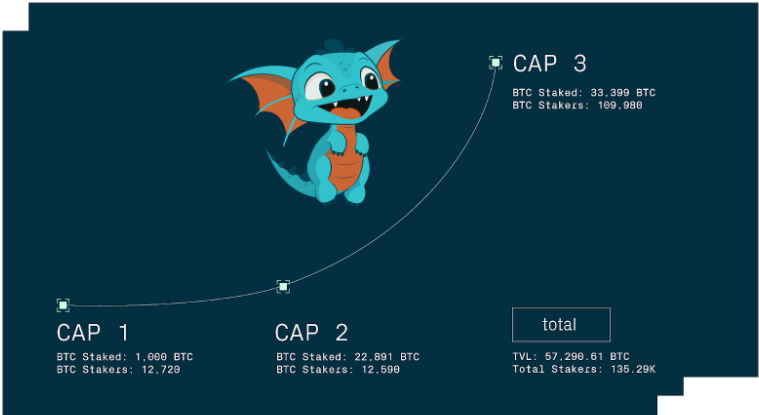
Source: https://babylonlabs.io/blog
1. Cap-1: Initial Limit of 1,000 BTC, Igniting Participation Enthusiasm
Time and Rules: Cap-1, as the starting phase of Phase-1, opened on August 22, 2024. For security reasons, Babylon set an initial staking cap of 1,000 BTC. Participation follows a first-come, first-served principle: staking transactions are recorded on the Bitcoin blockchain in chronological order, and once the cumulative total reaches 1,000 BTC, no more staking will be accepted. To encourage widespread participation, Cap-1 set a minimum of 0.005 BTC and a maximum of 0.05 BTC for each staking transaction. The 0.05 BTC cap ensures that at least thousands of transactions are needed to fill the 1,000 BTC limit, preventing a few whales from monopolizing all slots, making Cap-1 more like a community event that attracts a large number of ordinary BTC holders.
Participation Situation: After Cap-1 opened, the market response was exceptionally enthusiastic— the 1,000 BTC limit was sold out in just 3 hours. Statistics show that a total of 12,720 BTC stakers participated, submitting about 20,610 staking transactions. Such high participation even led to a 120-fold surge in Bitcoin network transaction fees: during the staking opening period, the total hourly transaction fee for Bitcoin skyrocketed from the usual 0.5 BTC to 60 BTC, as users were willing to pay high miner fees to secure staking slots.
Performance of Related Ecosystem Protocols: In Cap-1, Bitcoin LSD protocols occupied a significant share, providing users with a one-stop BTC staking entry and additional rewards. For example, Solv Protocol staked 250 BTC, accounting for 25% of the total limit. Solv not only aggregated user BTC through its product SolvBTC.BBN but also announced full reimbursement of BTC miner fees related to staking for all participants in Cap-1, reducing user costs. Additionally, RockX's Bedrock contributed about 297.8 BTC (approximately 30%); Lorenzo Protocol about 129.4 BTC (12.9%); PumpBTC about 118.4 BTC (11.8%); and Persistence's pSTAKE about 10 BTC (1%); ordinary retail users participating directly through exchange wallets made up the remaining portion. Babylon introduced a "Babylon Points" system to measure contributions. During Cap-1, each Bitcoin block allocated 3,125 points, distributed according to the proportion of active staked BTC in that block. These points are recorded under the user's public key and may be used for future reward distribution.
2. Cap-2: Significant Capacity Increase, Institutional Entry, and Billion-Level TVL
Time and Rules: After validating Cap-1, Babylon opened the second phase of Phase-1, Cap-2, on October 9, 2024. Cap-2 adopted a different strategy: it removed the total limit and instead limited the staking open window to only 10 Bitcoin blocks. Ten blocks take about 90 minutes, during which all valid staking transactions are accepted. Cap-2 also significantly increased the single staking limit to 500 BTC, allowing institutions to stake large amounts of BTC at once. Additionally, the point reward per block increased to 10,000 points, approximately 3.2 times that of Cap-1. The higher reward attractiveness and more relaxed limits indicate that Cap-2 aims to attract institutional players.
Participation Situation: In fact, Cap-2 attracted numerous institutions and custody platforms, resulting in an explosive growth in staking scale within just 10 blocks: a total of about 22,891 BTC was successfully staked during Cap-2, a figure more than 22 times that of Cap-1, propelling Babylon's total staking amount to the billion-dollar level and establishing Babylon as the "largest BTC staking platform in the world." Despite the total staked BTC soaring, the number of participating addresses in Cap-2 was 12,590, comparable to Cap-1. This indicates that Cap-2 was primarily composed of a small number of large stakes: in fact, statistics show that about 1,000 BTC addresses collectively staked over 23,000 BTC. Among them, Lombard Finance received about 22,503 BTC in delegation during the Cap-2 window, accounting for approximately 98%, almost monopolizing the vast majority of staking shares in Cap-2.
Performance of Ecosystem-Related Protocols and Cooperation Expansion: Cap-2 marks the official entry of institutions and large custodians onto the Babylon stage. Top compliant custodians such as Anchorage Digital and Hex Trust have announced support for their clients to participate in Babylon staking, facilitating large holders to earn additional BTC rewards. On the exchange side, Binance provides a one-click staking entry through its decentralized wallet (Binance Web3 Wallet) and launched related activities during Cap-2; OKX's OKX Earn has also partnered with Solv and others to offer Babylon staking services to users. In addition to Lombard leading the way, Solv continued to play a role in Cap-2; furthermore, Bedrock, Lorenzo, PumpBTC, and others launched "Cap-2 Pre-Staking" activities in advance to attract users to deposit BTC into their platforms.
3. Cap-3: Open Window and Points Incentives
Time and Rules: The final phase of Phase-1, Cap-3, opened on December 10, 2024, at 11:00 UTC, lasting until December 17, covering approximately 1,000 Bitcoin blocks (about one week). Cap-3 removes the total limit and adopts a time window system (lasting 1,000 blocks) to accept all staking transactions. During this period, the upper limit for each staking transaction is further increased to 5,000 BTC (up from 500 BTC in Cap-2), while the minimum remains at 0.005 BTC. Additionally, to further incentivize staking in the short term, Babylon introduced a tiered points reward system in Cap-3: the first 300 BTC blocks allocate up to 100,000 points per block, while the subsequent 700 blocks allocate 21,000 points per block. The 100,000 points per block reward is approximately 10 times that of Cap-2.
Participation Situation: Due to the relaxed restrictions and generous rewards, Cap-3 attracted a broader user base. Within the 7-day window, a total of 109,980 addresses participated in staking, accumulating 33,399 BTC, setting a new record for a single phase. The number of participants in Cap-3 surged, far exceeding the total of the previous two phases, indicating that a large number of small and medium BTC holders have also joined the Babylon staking ranks. Babylon has made more people aware of the way to stake "dormant" BTC for gains. Since Cap-3 has no total limit and a longer duration, Bitcoin chain transaction fees did not experience another surge, allowing staking transactions to be completed in a relatively stable environment.
Ecosystem Collaboration and Activities: Several partners took advantage of Cap-3 to launch joint incentive programs. For example, the Corn network, as one of the Bitcoin Secured Networks, announced that during Cap-3, it would issue additional "Kernels" points to BTC stakers. Additionally, Babylon organized community activities such as the "BTC Staking Marathon" with wallet and node service providers, offering badges and lottery opportunities to users who staked for a certain duration or amount. These initiatives further amplified on social media, enhancing Babylon's visibility. A total of 57,290.61 BTC successfully staked in Babylon Phase-1, accounting for approximately 0.27% of the circulating supply of Bitcoin, with 135,290 participating addresses. Babylon officially referred to Phase-1 as the supply-side launch: a large amount of BTC has been "warehoused for use," and the next Phase-2 will focus on the demand side, namely launching Babylon's own PoS chain and connecting more BSN networks, allowing these BTC to be truly put into secure production and generate actual returns.
3. Overview of the Babylon Ecosystem
In the rapid development process, Babylon has built a multi-layered ecosystem partner network covering infrastructure, protocol cooperation, wallet exchange support, and more. The strong collaborative landscape provides the driving force and synergy for Babylon's growth.
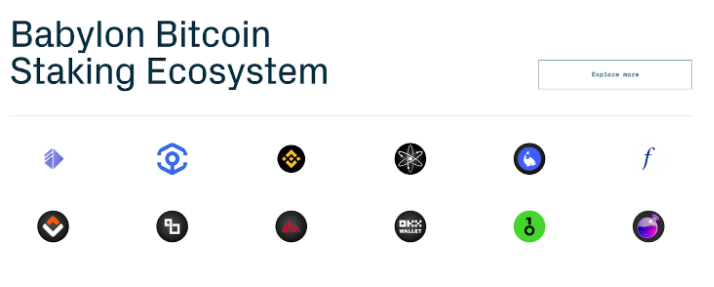
1. LST Protocol
The LST protocol addresses the liquidity issue for users staking BTC by issuing liquid staking tokens (LST). Currently, 12 mainstream LST protocols have adopted Babylon as their underlying staking channel, including Lombard, Bedrock, PumpBTC, Lorenzo, Solv, pSTAKE, Chakra, and emerging projects like Allo and Stakestone. Babylon provides security and sources of yield for them, while these protocols direct users to Babylon and enhance staking stickiness. For example, users staking BTC through the LSD protocol can receive dual rewards: Babylon points on one hand and tokens or points issued by the protocol on the other. Additionally, LST tokens (such as LBTC, uniBTC, etc.) can also be used for lending, providing liquidity, and other DeFi scenarios, further increasing the utilization of BTC assets.
2. Bitcoin Secured Network (BSN)
BSN refers to blockchain networks that integrate Babylon's Bitcoin staking security. Currently, 25 projects/networks have announced their candidacy for BSN, planning to connect to BTC security after Babylon Phase-2 goes live. Typical representatives include:
BOB (Build on Bitcoin): A hybrid Layer 2 that combines Bitcoin and Ethereum features to create a Bitcoin DeFi platform. BOB integrates with Babylon, using Babylon's BTC staking to provide final security for its L2, enhancing security credibility. BOB claims this makes it a "hybrid chain secured by Bitcoin" and plans to utilize Babylon for cross-chain asset bridging of BTC, ETH, and others.
Corn: An innovative network deployed on Arbitrum, Corn collaborates with Babylon to become the world's first BSN, layering Bitcoin and Ethereum security on Ethereum L2. To incentivize BTC stakers, Corn has also launched a "Kernels" points program, distributing Corn ecosystem points based on the amount of BTC staked by users over a certain period.
B² Network: A modular design Bitcoin Layer 2 project, B² embeds Babylon's BTC staking into its Hub consensus, introducing Bitcoin data availability sampling (DAS) and ZKRollup technology to create an "execution layer secured by BTC." Babylon staking provides economic guarantees for B² Rollup's validation, and B² also supports various DeFi operations for BTC staking derivatives on its Rollup.
Babylon, through the BSN initiative, extends its reach to blockchain projects across different tracks, including Layer 1 main chains, Layer 2 Rollups, oracle networks, and data availability layers, pushing the concept of BTC security as a service (BTC-as-a-Service) into reality: Babylon contributes nearly 60,000 BTC to the "security pool" for use by various networks, while these networks, in turn, introduce more applications and transactions, enhancing the activity and value capture on the BTC chain. This positive cycle has immense potential and positions Babylon uniquely in the cross-chain ecosystem.
3. Wallet and Exchange Support
To lower the participation threshold for users, Babylon actively collaborates with multiple mainstream crypto wallets and trading platforms. Binance not only developed a Web3 wallet supporting the native BTC staking interface but also launched a "BTC Staking to Earn Points" activity in its Earn financial section, allowing users unfamiliar with self-custody wallets to participate easily. OKX similarly integrates Babylon through OKX Earn and conducts joint promotions with Solv, PumpBTC, and others. Additionally, 12 Web3 wallets have announced support for Babylon Phase-1, including multi-chain wallets and Bitcoin-specific wallets. For example, decentralized wallets like ZenGo and Blocto have launched Babylon staking tutorials; the Bitcoin native wallet Xverse has also participated in discussions with the Ordinals community to connect with Babylon. The endorsement from wallets and exchanges has, to some extent, increased user trust in Babylon, serving as a form of "endorsement."
4. Infrastructure and Service Providers
In the Babylon ecosystem, node service providers and custodians also play important roles. Professional node operators such as Blockdaemon, InfStones, stakefish, and Figment have become part of Babylon's finality provider network, offering staking-as-a-service to clients. Custodians like Cobo and Coincover collaborate with LSD protocols (such as PumpBTC) to execute staking transactions on behalf of users while ensuring the security of BTC private keys. Compliance custodian giant Anchorage Digital has announced a Babylon staking channel for U.S. institutions, achieving "institutional-level one-click staking"; Asian custodian Hex Trust is also involved. The inclusion of these infrastructure partners makes it possible for large amounts of capital to safely enter Babylon, further decentralizing and enhancing the reliability of Babylon's network.
Through these multi-faceted cooperative expansions, Babylon has built a thriving ecosystem, where various parties in the Babylon ecosystem form synergistic effects—expanding staking scale attracts more partners, and conversely, the addition of partners further promotes the increase in staking scale.
4. Overview of Representative Projects in the Babylon Ecosystem
A number of protocols and applications centered around BTC staking have emerged in the Babylon ecosystem, each with its unique positioning, collectively enriching the Bitcoin DeFi landscape.

Source: https://dune.com/pyor_xyz/babylon-chain
1. Lombard Finance (LBTC)
Lombard is a protocol within the Babylon ecosystem focused on Bitcoin liquid staking, aiming to establish a market between BTC stakers and PoS chain demanders, connecting Bitcoin to every chain and DeFi protocol. Users can deposit BTC on the Lombard platform, and Lombard will proxy stake these BTC on Babylon to earn yields. At the same time, users can mint LBTC tokens on Ethereum at a 1:1 ratio. LBTC is an ERC-20 token issued by Lombard, representing the principal amount of BTC staked by users. Holders of LBTC can accumulate points on Babylon and also deploy LBTC into DeFi protocols, releasing the liquidity of staked assets. Lombard has launched the Lux and Luminary reward programs, where early participants can receive governance/reward tokens (Lux) issued by Lombard, which have not yet been publicly sold and may play a governance role after the Babylon mainnet goes live.
2. Bedrock (uniBTC)
Bedrock is a multi-asset liquid staking protocol incubated by the established node service provider RockX, supporting multi-chain staking for ETH, BTC, IoTeX, and more. Bedrock received investments from OKX Ventures and others in May 2024, focusing on providing institutional-grade liquid staking services. Its BTC staking token is named uniBTC. Bedrock's unique feature is supporting wBTC staking: users can stake WBTC directly on the Ethereum chain to Bedrock. Bedrock collaborates with custodians to stake an equivalent amount of real BTC on Babylon, allowing WBTC holders to participate in Babylon staking without directly operating on the Bitcoin chain. Bedrock offers two modes: one is "proxy staking," where users stake WBTC on Ethereum while Bedrock completes the BTC staking in the background; the other is "one-click exchange," where Bedrock helps users convert WBTC into BTC and stake it. Staking rewards are distributed in the form of uniBTC, which serves as a staking certificate for BTC issued by Bedrock on Ethereum and can be used in DeFi. Bedrock also supports staking for assets like BTCB on BSC and FBTC from Filecoin, empowering BTC derivative assets across different chains within Babylon.
3. PumpBTC (pumpBTC)
PumpBTC is a Bitcoin restaking protocol launched in 2024, with the slogan "Maximizing Returns for BTC Holders," centered around the pumpBTC token. PumpBTC adopts a cross-chain aggregation model: users can stake WBTC, BTCB, FBTC, and other BTC-pegged assets to receive pumpBTC tokens pegged at a 1:1 ratio. Subsequently, PumpBTC delegates an equivalent amount of real BTC to Babylon on the Bitcoin mainnet through partnered third-party custodians (such as Cobo and Coincover). The yields generated by Babylon are then converted back to pumpBTC, making pumpBTC a yield-accumulating LST. Additionally, PumpBTC has designed a points reward and team invitation mechanism, where staking any amount of pumpBTC earns pump points, which can be used to receive PUMP token airdrop rewards.
4. Lorenzo Protocol (stBTC)
Lorenzo is a Bitcoin yield finance layer based on Babylon, creating more yield opportunities for BTC staking through an innovative principal and interest separation model. The project received investment from Binance Labs in October 2022. Lorenzo introduces a dual-token design to represent BTC staking: after users stake BTC or BTCB on the Lorenzo platform, they receive an equivalent amount of stBTC (Stake BTC) as the principal token, along with continuously accumulating YAT (Yield Accumulation Token) as the yield token. Babylon's staking points and potential yields are reflected by YAT, while stBTC remains pegged 1:1 with the amount of BTC staked. This separation allows users to flexibly manage their yields and principal: for example, they can trade YAT to lock in future yields or lend stBTC for liquidity. Lorenzo operates through a staking agent mechanism, currently managed by official agents overseeing all staking operations: agents stake users' BTC on Babylon, monitor on-chain proofs, and correspondingly issue stBTC and YAT.
5. Solv Protocol (SolvBTC.BBN)
Solv is a well-known decentralized finance asset issuance and management protocol. In July 2024, Solv announced a partnership with Babylon to launch solvBTC.BBN, allowing BTC holders on networks like Ethereum, BSC, and Arbitrum to participate in Babylon staking and earn points rewards. Users lock BTC (or pegged BTC on various chains) on the Solv platform, and Solv ensures these BTC are staked on Babylon through custodians (such as Binance's custody division, Ceffu). Users then receive SolvBTC.BBN tokens, which can be used within the Solv ecosystem. Solv plans to expand SolvBTC into a multi-chain BTC reserve, connecting more PoS staking scenarios beyond just Babylon.
6. Chakra (Prana)
Chakra is a Bitcoin restaking protocol that combines zero-knowledge proofs and modular concepts, aiming to create a BTC settlement network for institutions. Chakra completed its financing in April 2024, with investors including StarkWare (a well-known ZK solution team for Ethereum) and ABCDE Capital. Chakra launched a BTC pre-staking pool, allowing users to deposit BTC into the Chakra pool before Babylon's mainnet launch, with these BTC managed in a multi-signature vault jointly by Chakra and custodial partners (such as Cobo). Once Babylon opens for staking, Chakra will stake the BTC from the vault on behalf of users. During this period, users earn incentive tokens Prana issued by Chakra (currently in point form) and are expected to enjoy a portion of the staking yields from Babylon. Chakra emphasizes ensuring the transparency and trustworthiness of the staking process through zero-knowledge proofs while protecting user privacy. Additionally, Chakra is committed to a modular blockchain architecture, planning to build an independent Chakra settlement network, with Babylon providing consensus security while the Chakra network handles transaction execution.
Five, Challenges and Prospects Facing Babylon
Despite Babylon achieving remarkable results in 2024, it still faces numerous challenges for long-term success. At the same time, the market environment and technological trends present a series of valuable opportunities for Babylon. This section comprehensively discusses the core challenges currently faced by the Babylon ecosystem and its development prospects.
1. Core Challenges
Technical Complexity and Security: The Babylon protocol involves a complex combination of Bitcoin scripts, Cosmos chains, cross-chain validation, and other technologies, with extremely high security requirements. The limitations of the Bitcoin mainnet (1MB blocks, low script programmability) mean that Babylon's staking transactions must be highly optimized; otherwise, they risk causing network congestion and even provoking backlash from parts of the Bitcoin community. Babylon needs to continuously prove that it will not negatively impact the BTC mainnet and even demonstrate benefits to the mainnet (such as increasing miner fee revenue, improving UTXO utilization, etc.). Additionally, the security of the Babylon chain itself is crucial: as a finality hub, if the Babylon chain is attacked or malfeasant, it could affect the security of all BSN networks.
Economic Model and Sustained Incentives: During Phase-1, users only received Points, which cannot be directly redeemed for yields. While this arrangement may be acceptable in the short term, a long-term lack of tangible returns could dampen user enthusiasm. Therefore, Babylon needs to present a clear economic incentive model in Phase-2 and beyond. This includes whether Babylon will issue its own tokens and airdrop them to Points holders, and whether BTC stakers can receive native rewards on PoS chains (such as tokens from BSN chains or Babylon block reward shares). Without sustained yield incentives, large BTC holders may not be willing to lock up their assets long-term. Furthermore, when Babylon allows the same BTC to participate in multi-chain staking, how to allocate yields and risks also poses a challenge.
Competition and Alternatives: Although Babylon currently has almost no direct competitors in the "BTC staking" field, this does not mean that other solutions will not emerge in the future. For instance, advocates of the Stacks ecosystem and Drivechain may propose different cross-chain yield solutions for BTC; Ethereum's EigenLayer may also expand to support WBTC staking, diverting BTCFi demand. Additionally, CeFi institutions are also offering BTC lending and other yield products. If a simpler "earn BTC yields effortlessly" solution emerges, Babylon may face user attrition.
User Education and Experience: Bitcoin users have long been accustomed to "holding coins without action," and getting them to participate in staking for yields requires a shift in mindset and a sufficiently convenient experience. Although Babylon collaborates with multiple wallets, staking still involves details like UTXO selection and fee settings, which general users may not be familiar with. Especially for small holders, high on-chain BTC fees can be a barrier. Therefore, enhancing user experience (UX) is one of the challenges: including a more user-friendly staking interface, more transparent yield expectation displays, and lowering participation thresholds.
2. Development Prospects
Launch of Babylon Chain: The highlight of Phase-2 is the launch of the Babylon autonomous Proof-of-Stake blockchain, known as Babylon Genesis. According to official statements, the Babylon chain will be the first blockchain to truly use BTC locking to provide economic security. It will also be the first Bitcoin Secured Network (BSN), built on the Cosmos SDK. The launch of the Babylon chain means that nearly 57,000 BTC staked during Phase-1 will finally have a purpose; the Babylon chain will serve as the backbone of the entire Babylon ecosystem: consolidating BTC staking security, providing finality services to other connected chains, and managing the relationship and reward distribution between stakers and finality providers.
Issuance and Use Cases of Babylon Tokens: Babylon is expected to launch a native token for governance and on-chain fee payments, distributed through airdrops to Phase-1 points holders, BSN partners, and others to ensure community participation. If issued, the Babylon token will empower holders to vote on protocol upgrades and parameter adjustments, and may capture a portion of the revenue (for example, charging service fees to BSN and redistributing them to token stakers). As an independent network, the Babylon chain needs to design a gas fee mechanism. Since BTC cannot be used directly as gas on-chain, Babylon may adopt its own token or stablecoin as a means of gas payment. The economic model of the Babylon chain will also clarify the distribution of interests among stakers, validators (finality providers), and BSN users.
Multi-Chain Staking and Comprehensive Interconnection: After the Babylon chain operates stably, the team's next goal is to achieve multi-chain staking with a single coin, allowing Bitcoin holders to stake the same BTC on multiple BSNs simultaneously, facilitated by introducing sub-staking shares. For example, if a user locks 1 BTC in Babylon, the Babylon chain can allow the user to choose up to N BSNs for staking, assigning a weight ratio or share to each BSN, with that BTC counted as a certain amount of staked value on each chain to earn rewards from that chain. This shared staking concept is akin to turning BTC into a pegged "staking certificate," with PoS chains sharing the security value of this certificate through Babylon.
Conclusion
The Babylon protocol successfully addresses the historical challenge of Bitcoin's inability to be natively staked through innovative mechanisms, opening a new model for BTC participation in PoS chain security. Babylon explores how 210 million Bitcoins can integrate into a broader blockchain economy. As HashKey Research Institute states, Babylon opens a new chapter in enhancing Bitcoin's capital efficiency. If its vision is fully realized, Bitcoin will not only be "digital gold" but will also become the "digital energy" of various blockchains, continuously providing security while also generating returns. This positive cycle will solidify Bitcoin's core position in the crypto world, making BTCFi an indispensable part of the DeFi landscape.
In 2025, we expect to witness a paradigm shift from static holding to dynamic staking for BTC, with various emerging protocols based on BTC thriving on the Babylon chain. As the Babylon team advocates for a "BTC Renaissance," a prosperous era belonging to Bitcoin DeFi is on the horizon.
About Us
Hotcoin Research, as the core research and investment hub of the Hotcoin ecosystem, focuses on providing professional in-depth analysis and forward-looking insights for global crypto asset investors. We build a "trend analysis + value discovery + real-time tracking" service system, offering in-depth analysis of cryptocurrency industry trends, multi-dimensional assessments of potential projects, and all-weather market volatility monitoring, combined with weekly live strategy broadcasts of "Hotcoin Selection" and daily news updates from "Blockchain Today," providing precise market interpretations and practical strategies for investors at different levels. Leveraging cutting-edge data analysis models and industry resource networks, we continuously empower novice investors to establish cognitive frameworks and assist professional institutions in capturing alpha returns, collectively seizing value growth opportunities in the Web3 era.
Risk Warning
The cryptocurrency market is highly volatile, and investment carries risks. We strongly recommend that investors conduct investments based on a complete understanding of these risks and within a strict risk management framework to ensure the safety of their funds.
Website: https://lite.hotcoingex.cc/r/Hotcoinresearch
免责声明:本文章仅代表作者个人观点,不代表本平台的立场和观点。本文章仅供信息分享,不构成对任何人的任何投资建议。用户与作者之间的任何争议,与本平台无关。如网页中刊载的文章或图片涉及侵权,请提供相关的权利证明和身份证明发送邮件到support@aicoin.com,本平台相关工作人员将会进行核查。
